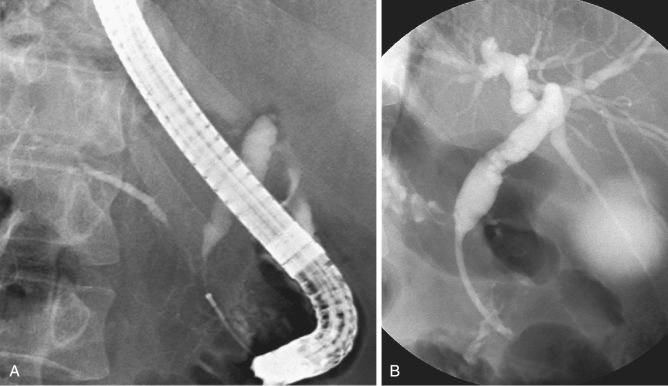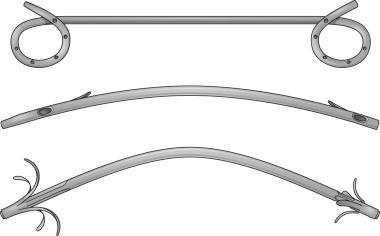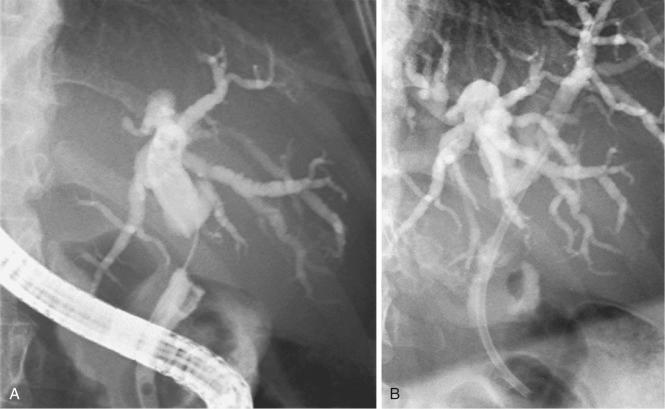Physical Address
304 North Cardinal St.
Dorchester Center, MA 02124
Pancreaticobiliary malignancies comprise a mixed bag of cancers including pancreatic cancer, carcinoma of the ampulla of Vater, duodenal carcinoma, gallbladder carcinoma, and cholangiocarcinomas. When they are located at the level of the liver hilum, cholangiocarcinomas are referred to as Klatskin's tumors . Although there are marked differences in biologic behavior and clinical outcome, the overall prognosis of these tumors is dismal. At the time of presentation, more than 80% to 90% of patients have locally unresectable disease or distant metastases, leaving only a few patients suitable for curative resection. Other treatment modalities such as chemotherapy and radiotherapy have little to no effect on survival, although various multimodality schemes in a (neo)adjuvant setting to surgery are currently being explored. Hence many patients, sooner or later in their disease course, are in need of optimal palliative treatment directed toward relief of jaundice, pain, and gastric outlet obstruction.
More than 85% of patients with pancreaticobiliary malignancies develop obstructive jaundice, and often it is a presenting symptom. Endoscopic retrograde cholangiopancreatography (ERCP) with placement of plastic or metallic self-expandable biliary stents has become the standard of care to relieve jaundice and has largely replaced surgical treatment. In case of failure of ERCP, percutaneous transhepatic cholangiographic drainage (PTCD) or endosonographic guided (EUS) biliary drainage are alternative treatment options.
Of all pancreaticobiliary malignancies, pancreatic adenocarcinoma has the highest incidence. It is the fourth leading cause of cancer death in the United States, and it is estimated that in 2016 approximately 53,070 people will be diagnosed with pancreatic cancer, and 41,780 will die as a result of the disease. It is predicted to become the second leading cause of cancer death in the United States by 2030. Only a minority of patients (10% to 20%) are suitable candidates for curative resection, although this number is increasing with the advent of (neo)adjuvant chemo(radiation) therapy. The overall 5-year survival rate is still less than 4%. For patients having undergone a surgical resection it is less than 20%. Tobacco smoking doubles the risk of pancreatic cancer. Patients with chronic pancreatitis have an increased risk for developing pancreatic cancer that is estimated at 4% per 20 years. The risk of developing pancreatic cancer in patients with hereditary pancreatitis is 20% to 40%, with smoking as an important risk modifier.
The incidence of gallbladder carcinomas averages 1 per 100,000 person-years, but is considerably higher among Native Americans. Patients most likely to survive are those in whom early cancer is detected in a postcholecystectomy specimen, with a 5-year survival of 80% to 100% for early T1–T2 cancers. For locally advanced T3/4 tumors, survival drops to 10% to 30%. Gallstone disease is the most important risk factor for gallbladder cancer.
Hilar cholangiocarcinoma originates from the biliary epithelium at the hepatic confluence. Radical surgical resection of the tumor offers the only chance for long-term survival, with 5-year survival rates reported between 25% and 40%. The median survival of patients with unresectable disease is only 12 to 15 months. Neoadjuvant chemoradiation followed by orthotopic liver transplantation has been employed for the treatment of patients with unresectable, nonmetastatic, perihilar cholangiocarcinoma with encouraging results. Established risk factors for cholangiocarcinoma include parasitic infection of the biliary tract, primary sclerosing cholangitis (PSC), bile duct cysts, hepatolithiasis, and toxins (e.g., Thorotrast).
Duodenal cancer is a rare condition that may occur sporadically, but patients with multiple duodenal adenomas, such as those that occur in familial adenomatous polyposis (FAP) and Gardner syndrome, are at particularly high risk.
Ampullary carcinoma is a rare condition with an incidence of 0.49 per 100,000 persons. Biliary obstruction usually develops early in the course of the disease. As a result, tumors are often relatively small, and radical resection is possible in a large proportion of cases with an overall 5-year survival rate of 50%.
The most common presenting symptoms of pancreaticobiliary malignancies are painless jaundice, anorexia, and weight loss. If pain occurs, it is most often located in the epigastric region or right upper quadrant and may radiate to the back. Back pain usually indicates retroperitoneal tumor infiltration and unresectability. Other symptoms related to obstructive jaundice include dark urine, pale stools, and pruritus. At the time of presentation, approximately 80% of patients with pancreatic cancer have impaired glucose tolerance or diabetes mellitus. Carcinoma of the body and tail of the pancreas manifests with similar features, although jaundice is usually absent or develops very late in the course of the disease.
Approximately 90% of pancreaticobiliary malignancies are ductal adenocarcinomas ( Fig. 63.1 ). Most tumors arise from the pancreatic head. Other exocrine malignancies are mucinous cystic adenocarcinoma and acinar cell carcinomas. Endocrine tumors include gastrinoma and insulinoma. Metastases of a primary tumor (mammary, lung, and melanoma) and lymphoma are rare but must be considered because of important treatment implications (e.g., chemotherapy) that influence prognosis. Mesenchymal tumors are extremely rare.

The definitive diagnosis of malignancy is dependent on acquiring a tissue diagnosis. Currently, with various means of tissue acquisition that all have proven to be safe procedures, it is advisable to always attempt to obtain a tissue diagnosis for diagnostic confirmation regardless of management consequences. Evidently it is a prerequisite when (neo)adjuvant or palliative chemo(radio) therapy is considered. If an ERCP is indicated for biliary drainage, one can attempt to obtain a tissue diagnosis by means of brush cytology, intraductal biopsies, or fluid collection from the bile duct or pancreas or both. Cytologic brushings are easy to obtain. Specificity approaches 100%, but sensitivity is relatively low, ranging from 30% to 45%. The yield of intraductal forceps biopsies is higher compared to brush cytology and approaches 50% to 60%. Sampling of ductal fluid is a simple method that is not widely used, but may offer an additional way of obtaining a tissue diagnosis. Several studies have shown that sensitivity can be increased by combining various techniques of tissue sampling. Endoscopic ultrasound (EUS)–guided fine-needle aspiration (FNA) or biopsy (FNB) has an excellent sensitivity of 85% to 90% and specificity that approaches 100%. Although FNB provides the opportunity to obtain tissue cores with preservation of cellular architecture, thereby potentially increasing sensitivity and accuracy (including a better opportunity for advanced tissue processing, such as immunohistochemical analyses), that verdict is still out. Percutaneous computed tomography (CT)-guided FNA biopsy is another method for confirmation of malignancy, with a reported sensitivity of 60% to 90%. Some have argued that, because of the risk of needle tract seeding, this technique should only be used in cases of unresectable disease.
Single-operator digital cholangioscopy (SOC) and probe-based confocal laser endomicroscopy (pCLE) are recent additions for determining the nature of indeterminate biliary strictures. In a multicenter, observational study, SOC was performed in 44 patients with indeterminate biliary strictures. The sensitivity and specificity of SOC visual impression for diagnosis of malignancy was 90% and 95.8%, respectively. All 44 patients underwent SOC-guided biopsies of which specimens were adequate for histologic evaluation in 43 patients (97.7%). The sensitivity and specificity of SOC-guided biopsies for diagnosis of malignancy was 85% and 100%. In a prospective, international, multicenter study, pCLE was investigated in 112 patients with indeterminate biliary strictures, of which 71 finally proved to be malignant. ERCP and pCLE had an 89% sensitivity, 71% specificity, and 82% accuracy rate for the correct diagnosis of the nature of the biliary stricture.
Adequate discrimination between a benign or malignant nature of a pancreatic head lesion is pivotal, as management differs substantially. In the case of the former, surgery may not be indicated and even harmful to the patient. In the latter case, surgery is the treatment of choice, if a lesion proves to be resectable. An enlarged pancreatic head may be caused either by pancreatitis or by carcinoma. Autoimmune pancreatitis is a condition that is increasingly recognized and may mimic a malignant tumor. Differential diagnosis is based on a distinct clinical picture with a diffusely enlarged pancreas with a nondilated pancreatic duct, elevated IgG4 levels, and a prompt response to corticosteroid therapy with improvement of clinical symptoms, including jaundice, and resolution of morphologic abnormalities on cross-sectional imaging.
Paraduodenal pancreatitis, also known as groove pancreatitis, may also mimic pancreatic adenocarcinoma. This condition is associated with chronic pancreatitis, male gender, and alcohol abuse. Cross-sectional imaging typically demonstrates an enhancing mass in the paraduodenal space, with medial duodenal wall thickening and multiple cysts.
Cystic lesions of the pancreas may be benign (pancreatic pseudocyst or serous cystadenoma), premalignant (intrapancreatic mucinous neoplasm [IPMN] mucinous cystadenoma), or malignant (cystadenocarcinoma, malignant degenerated IPMN). Radiologic imaging is used to characterize these lesions, although differential diagnosis, as well as assessing the degree of neoplastic progression, is notoriously difficult and challenging. EUS in combination with FNA, fluid analysis, intracystic biopsy, and probe-assisted CLE may increase diagnostic accuracy.
Whenever there is a suspicious stricture in the mid–bile duct or proximal bile duct, a gallbladder carcinoma should be considered. It is also important to exclude benign causes of strictures, such as Mirizzi's syndrome, primary and secondary sclerosing cholangitis, and postoperative conditions. An algorithm for the diagnosis of pancreaticobiliary cancer is presented in Fig. 63.2 .

Since the introduction of endoscopic biliary stent therapy in 1980, the management of biliary obstruction due to pancreaticobiliary malignancies has changed considerably. Nowadays, endoscopic stent placement is the preferred treatment to relieve jaundice ( Fig. 63.3 ). Compared with percutaneous and surgical drainage, endoscopic biliary stent therapy is associated with lower morbidity and mortality rates. A potential complication of endoscopic biliary drainage is late stent occlusion causing recurrent jaundice, or cholangitis, which necessitates stent exchange. The technical success rate of endoscopic biliary drainage is between 70% to 90% and is higher for distal tumors compared with proximal malignancies involving the bifurcation. The complication rate of therapeutic ERCP is 5% to 10%.

Nowadays ERCP is almost exclusively a therapeutic procedure. Magnetic resonance imaging (MRI) and EUS have largely replaced it for diagnostic purposes. Clinical symptoms that prompt biliary drainage via ERCP include jaundice, fever, and pruritus. Biliary stent placement has been shown to improve symptoms of anorexia and quality of life. It has also been suggested that preoperative biliary drainage may improve surgical outcome after pancreaticoduodenectomy, but this has not been substantiated in clinical trials. In a randomized study comprising 202 patients with pancreatic head carcinoma comparing direct surgery with delayed surgery after biliary drainage, surgical outcome and complication rates were not affected by preoperative stent placement. The overall complication rate in the delayed surgery group with preoperative stent placement was significantly increased, mainly owing to stent-related complications. The outcome of this study strongly argues against standard preoperative drainage in patients with pancreatic head cancer in whom immediate surgery is planned. Preoperative drainage is indicated, however, when operative resection is not imminent; for example, because serum bilirubin exceeds 14 mg/dL, or when patients need to undergo neoadjuvant chemotherapy. In such cases, biliary drainage should be accomplished by inserting a metal biliary stent, as stent-related complications (occlusion and exchange) are significantly lower (6% versus 31%) compared to plastic stenting.
There are few absolute contraindications to perform ERCP. Coagulation disorders are a relative contraindication and should be corrected before ERCP.
The median patency of a conventional 10-Fr plastic stent is 3 to 6 months. The incidence of stent occlusion is 20% to 50%. The initial event in stent blockage is adherence of proteins and bacteria to the inner wall of the stent and subsequent formation of a biofilm. Bacteria are introduced into the biliary system during transpapillary placement of the stent. Sludge forms from the accumulation of bacteria, which produce β-glucuronidase and form calcium bilirubinate and calcium palmitate. Many efforts have been made to prolong stent patency, some of which are discussed in the following paragraphs.
The first biliary stents that were placed were only 7-Fr or 8-Fr in diameter because of limitations of the diameter of the working channel of the endoscope (2.8 mm). When side-viewing endoscopes with large-diameter working channels (4.2 mm) were introduced in 1980, it became possible to insert large-bore plastic stents. Larger stents (10-Fr) perform better than smaller stents (7- or 8-Fr) because of the higher flow rate, as predicted by Poiseuille's law, and because there is less stasis with larger diameter stents. Theoretically, bile flow rate is proportional to the internal diameter raised to the fourth power; even a small increase in diameter results in a substantial increase in flow capacity. Contrary to this hypothesis, the use of even larger diameter plastic stents of 11.5-Fr or 12-Fr did not result in further improvements in stent patency.
The first biliary stents had a pigtail configuration at the proximal end to provide better anchorage. Straight stents were developed because of their improved bile flow characteristics compared with pigtail stents ( Fig. 63.4 ). Huibregtse and Tytgat developed the Amsterdam-type stent—a straight design with two side holes to facilitate biliary drainage and two side flaps to prevent dislocation—which has been the standard type of stent since 1980. Sludge in plastic stents mainly accumulates around side holes. This accumulation seems to be the result of higher intraluminal flow turbulence and decreased flow rates. Soehendra and others postulated that elimination of side holes might improve patency rates and designed the so-called Teflon Tannenbaum stent (a straight stent without side holes and with multiple proximal and distal side flaps to prevent dislocation). At first, uncontrolled results were encouraging, with patency rates comparable to metal stents, but randomized trials could not confirm these initial results. Omitting side holes in a standard-design polyethylene stent also did not improve stent patency.

Different materials have been used for stent construction, including polyethylene, polyurethane, and polytef (Teflon). In vitro studies have shown a direct relationship between the coefficient of friction and the amount of encrusted material. Teflon has the lowest friction coefficient and the best potential for preventing stent clogging. Initially, Teflon Tannenbaum stents showed a favorable patency rate. A randomized study comparing Amsterdam-type stents made from polyethylene versus Teflon did not show a difference in stent patency. Other controlled clinical trials also could not confirm the superiority of Teflon material in a Tannenbaum-design stent. Scanning electron microscopy of out-of-package biliary stents has shown that the inner surface smoothness of plastic stents is highly variable. This variability is possibly a result of the manufacturing process of plastic stents by extrusion. Only the polyurethane stent was found to have an extremely smooth surface. Two new polymers were introduced with an ultra-smooth surface, Vivathane and Hydromer. Both materials have been shown to reduce bacterial adherence in vitro. In addition, the Hydromer stent not only has a smooth texture but also a coating that absorbs water and provides a hydrophilic sheath. Because bacteria initially attach by hydrophobic interactions, this coating could potentially lower bacterial adhesion and increase stent patency. However, the encouraging results of in vitro studies could not be confirmed in prospective clinical trials.
Priming the inner surface of a stent with a coating that comprises some form of antiadhesive property may reduce biofilm formation and stent clogging. Antibiotics, antithrombotics, silver, and hydrophilic coating all were effective in reducing bacterial colonization in vitro. However, clinical studies using antibiotic-coated or hydrophilic-coated stents did not show any benefit.
Placing a plastic stent entirely within the common bile duct has the theoretical advantage of preserving the barrier function of the sphincter of Oddi; this prevents duodenal reflux of food and bacteria into the stent and biliary tree. This so-called inside stent approach can be performed only when a free margin of 1 to 2 cm is maintained between the distal end of the stricture and the papilla. With this parameter in mind, approximately one-third of patients with malignant obstructive jaundice are potential candidates for such treatment. However, for plastic stents no difference was found in stent performance in a randomized trial. In the inside stent group, stent migration occurred significantly more often.
Bacteria can enter the bile duct through the portal circulation, but more easily directly from the duodenum. When an endoprosthesis is placed, the barrier function of the sphincter of Oddi is lost, and bacteria enter the biliary tract freely. Sludge may form because these bacteria produce β-glucuronidase and form calcium bilirubinate and calcium palmitate. To prolong stent patency, prophylactic treatment with antibiotics seemed a logical step. In vitro studies showed that antibiotic treatment reduced bacterial adherence to plastic stents. In a prospective randomized study with ciprofloxacin, no difference in stent patency was found. In another study, rotating antibiotics (cycles of 2 weeks of ampicillin, metronidazole, and ciprofloxacin) were combined with ursodeoxycholic acid, and no difference in stent patency was shown. Only one small pilot study showed a reduced rate of stent blockage with norfloxacin plus ursodeoxycholic acid. Other studies combining antibiotics and bile salts (ofloxacin and ursodeoxycholic acid, ciprofloxacin, and rowachol) did not show a longer duration of stent patency. There is no compelling evidence that stent patency benefits from antibiotic prophylaxis.
Become a Clinical Tree membership for Full access and enjoy Unlimited articles
If you are a member. Log in here